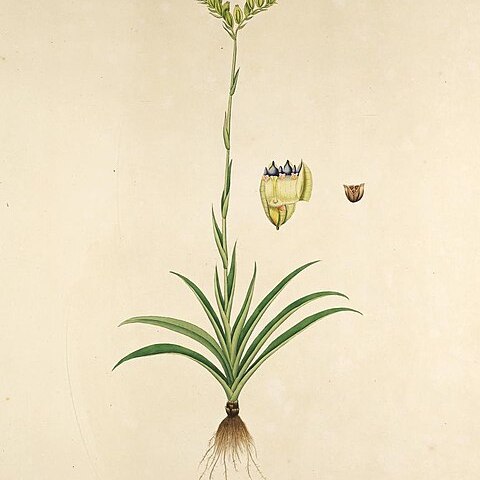Robust annual, up to 75 cm. Stem usually simple, forked into the inflorescence. Rosette distinct; leaves linear or lanceolate, acute, up to 15 cm by 13 mm. Stem leaves reduced to appressed, lanceolate, acute or acuminate scales, up to 7 cm by 7 mm, imbricate in the lower part of stem; upper part of stem often leafless. Inflorescence branches up to 8 cm. Bracts lanceolate, acute, about 5-12 mm. Flowers sessile or shortly pedicellate, blue or purplish, often with yellow-tipped, greenish lobes, rarely yellow, 10-20 mm. Outer perianth lobes triangular, acute, 2½ mm; margin thick, double in the basal part. Inner lobes linear-lanceolate, fleshy, obtuse, 1-1½ mm. Perianth tube cylindrical-trigonous, 3-4½ mm. Connective broad, provided with 2 distinct, acute apical crests and a broad, obtuse to almost truncate, basal, hanging spur. Style thick-filiform, bearing 3 sessile, funnel-shaped stigmas; style with stigmas about 3 mm. Ovary ellipsoid to obovoid, truncate, attenuate towards the base, up to 1 cm. Flower wings elliptical, 10-18 by ½-2½ mm, continuing as crests on the back of the outer perianth lobes, decurrent along the short pedicel. Capsule obovoid, truncate, irregularly dehiscing with transverse slits.
More
Plants with chlorophyll, autotrophic, flowering when 12.5-70 cm tall. Stems green, robust. Basal rosette leaves numerous, linear-lanceolate, 0.2-1.7 × 0.3-2 cm. Cauline leaves linear, 1.5-8 × 0.2-1 cm. Inflorescences 8-20-flowered; bracts lanceolate, 0.5-2.4 cm. Flowers pedicellate, bluish purple or yellow, 1-2.6 cm. Perianth tube 3-8 mm; wings conspicuous, 1-3.5 mm wide; outer tepals triangular, 1.5-4.5 mm, margin double and shallow; inner tepals lanceolate, 1-2 mm, margin single or double and shallow. Stamens sessile; connectives with 2 apical crests and a pendent basal spur. Ovary ellipsoid, 6-12 mm. Capsule obovoid. Seeds ellipsoid. Fl. Apr-Jun, fr. Jun-Sep. 2n = ca. 136.
A species with a large ecological amplitude. It has been collected in brush-wood, swamps and bogs among Sphagna, moist hollows, open grasslands, mountain meadows, marshy plateaus, on bare rocks, and has even been recorded as growing in water; ascending to ca 3500 m alt.


